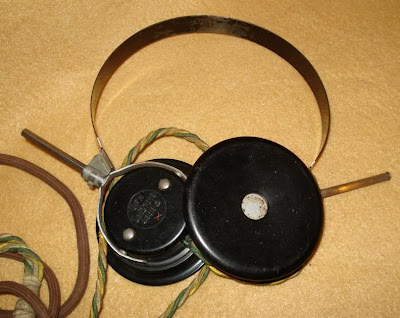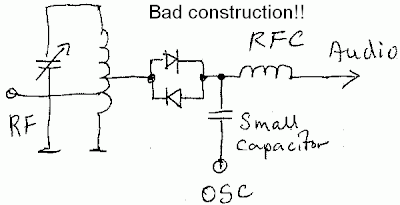Good questions Michael. When I saw
the SPRAT article I too was struck by the fact that it didn't give a value for
the coil. But DK2RS did have a large value variable capacitor... And he
was billing this as a dual-band (80-40) rig. So I figured he wanted that
LC circuit to resonate as low as 3.5 MHZ and as high as 7.3 MHZ. So, with
a variable cap that goes up to 350 pf, what value L should I use? I
started by calculating the resonant frequency of the frequency mid-way point:
5.1 MHz. I figured the variable cap should be around 162 pf at the
mid-way point. At this point I went to the on-line resonant frequency
calculator: https://www.1728.org/resfreq.htm (a
REALLY useful site!). This site revealed I needed a coil of about 6
uH. This put me in the ballpark. But then -- with the site --
I tested it with the values of the variable cap I had on hand. Mine was
23pf to 372 pf. (you really need an LC meter to do this kind of
thing).
Again at the resonant freq calculation site: 23 pf and 6uH = 13.5 MHz 372 pf and 6 uH = 3.3688 MHz
This would have been OK, but I wanted to move the frequency range down a bit, so I tried. 6.5 uH
23 pf and 6.5 uH = 13 MHz
372 and 6.5uH = 3.23 MHz
Now, how many turns? First look at the overall coil -- don't worry about taps at this point. I use the Toroid Turns Calculator: http://toroids.info/
Start by asking yourself "What core do I have on-hand? Let's say you have a T-50-2 (red/clear). The calculator shows you need about 36 turns. Do-able, but physically kind of tight.
I found a big core in my junk box. A T-106-2. The calculator showed I'd need about 22 turns on this core. It was much easier to get these turns on the larger core.
You have to measure the core after you wind it to make
sure you are at the desired inductance. One side of the main coil
went to ground, the other side to the top of the variable cap.
Now for the taps and secondaries: The schematic shows a tap. This is usually about 1/4 of the number of turns up from ground. I picked about 5 turns, and wound a little tap in there at that point -- that tap went to the antenna. You also have a secondary coil --no value is given, but based on experience I guessed around 5 turns -- I wound these turns on top of the primary one lead went to ground, the other went to the diodes and the switch.
The last thing to do is to see if the circuit resonates on both bands that you want to receive. You can do this with a signal generator, or with the band noise: Hook up an 80 meter antenna. Put the cap closer to its max value and tune the cap -- can you hear band noise? Or can you hear (or see on a 'scope) a signal at 3.5 MHz? You should be able to peak it with the main cap. Try to do the same thing on 40 meters -- here the variable cap should be closer to minimum capacity.
That's it. That's how I did it. You can do it too! Good luck with the Polyakov.
One hint: Building the VFO is the hard part. You can get started by using a signal generator in place of the VFO. Just make sure you have the level right -- around 620 mV input.
Good luck -- Let us know if you have trouble. And please let us know how the project goes.
73 Bill N2CQR






































